
table of contents
- Why prefer flowers?
- Flowers to prefer A - K
- Flowers to prefer L - O
- Flowers to prefer P - Z
- Light or dark germs?
- Seed pot and substrate
- Seeding procedure
- Prick out
- Dahlias & Co
Annual summer flowers bring a colorful splendor to the garden all summer until autumn. They are extremely easy to care for and can fill some dreary gaps in the perennial bed. By pulling the flowers forward on the windowsill, the joy of the floral wonders is extended even further. It's not at all difficult to do, even for beginners. In the following we will show you how to proceed and have put together suitable flowers for you.
Why prefer flowers?
Usually the annual summer flowers are only sown outdoors at a time when temperatures are rising and the soil is slowly warming up. Then the conditions are favorable for the seeds to germinate. Usually sowing in the open air does not take place until the end of March to the beginning of April. Temperature fluctuations can then still occur, which prevent the seeds from germinating. There would be failures.
It should also be mentioned that seedlings in the wild are a very popular source of food for birds and, above all, snails. In comparison, flower plants grown in the greenhouse or in the house on the windowsill can score with a certain advantage in terms of growth. The best time to sow indoors is from late February to early March. But there are other advantages:
- Plants are more robust
- cheaper than bought young plants
- bloom earlier, from May or earlier
- thus longer flowering time
- Location can be chosen individually
As with Herbs and Vegetables Advancing flowers on the windowsill in the house is not difficult. The only important thing is the correct soil mix, the location and the sowing container. We will show you in detail later how you can do this. Now first of all to the flowers.
Flowers to prefer A - K
There are a variety of summer flowers that are particularly suitable for growing indoors. You can then close gaps in perennial beds, but also cut a fine figure in pots and buckets. Many of the annual flowers are suitable as cut flowers and are used in colorful summer bouquets. Here is a small selection of suitable flowers to bring out in the house.
Asters (Callistephus chinensis)

- Flowering July to October
- Height up to 60 cm
- Sow late February to early March
- Floor temperature 15 to 20 degrees
- Germination time 10 to 15 days
- Prick out plants with four leaves
- later: sunny, well drained, calcareous soil
- change location annually
Balsamines (Impatiens balsamina)

- Synonym: garden balsam
- for beds, borders and pots
- Flowering period May to October
- Height of growth 60 cm
- Sow in early March
- under glass at 18 degrees
- Germination time 15 to 20 days
- Light germs
- Press the seeds on
- later: sunny to partially shaded location
- loose, well-fertilized soil
Chabaud's carnation (Dianthus caryophyllus)

- popular cut flower
- Growth height up to 50 cm
- Flowering July to October
- Sow in February
- Floor temperature 18 to 22 degrees
- Seed depth 0.5 cm
- Germination time 7 to 14 days
- keep moist
- later: sunny location
- loose, poorly fertilized soil
- break out side shoots for large flowers
Cosmee (Cosmos bipinnatus)

- Synonym: jewelry basket
- profuse blooming
- for beds and borders, for cutting
- Growth height up to 80 cm
- Flowering period May to October
- bee friendly
- Frequent pruning promotes flower formation
- Sow from February to early March
- Floor temperature 18 to 20 degrees
- Germination time 8 to 14 days
- Cover with 1 cm of soil
- keep moist
- later: sunny location
- permeable soils
Nasturtium (Tropaeolum majus)

- Creeper for trellises and fences
- helps against aphids
- Growth height up to 300 cm
- Flowering period June to September
- Sow in March
- Floor temperature 15 degrees
- Germination time 14 to 20 days
- always 2 to 3 seeds in a pot
- Seed depth 2 cm
- keep moist
- Later: sunny to partially shaded location
- leaner soils
Flowers to prefer L - O
Levkoje (Matthiola incana)

- Group planting for beds, borders, cottage gardens
- durable, fragrant cut flower
- Growth height up to 70 cm
- Flowering period May to September
- Sow in February
- Floor temperature 10 to 18 degrees
- Germination time 7 to 14 days
- Press the seeds on
- Light germs
- keep moist
- Continue to cultivate seedlings at 10 to 12 degrees
- later: sunny location
- loamy, nutrient-rich soil
Lobelia (Lobelia erinus)

- Synonym: loyal to men
- for balcony boxes, buckets, traffic lights, flower beds
- Growth height up to 15 cm
- Flowering period April to October
- Sow in February
- Light germs
- Press the seeds on
- Floor temperature 20 to 22 degrees
- Germination time 2 to 3 weeks
- Prick in bunches into pots
- keep feet warm
- later: sunny
- fertilize regularly
Snapdragon (Antirrhinum)

- for group planting for beds and borders
- Cut flower
- Growth height up to 70 cm
- Flowering period May to October
- Sow in February
- Floor temperature 15 to 23 degrees
- Germination time 10 to 14 days
- Cold germ
- Cold period before germination 10 days at 5 degrees
- cover lightly with soil
- set up light and airy
- later: sunny to partially shaded location
- humus, calcareous soil
Almond rose (Clarika unguiculata)
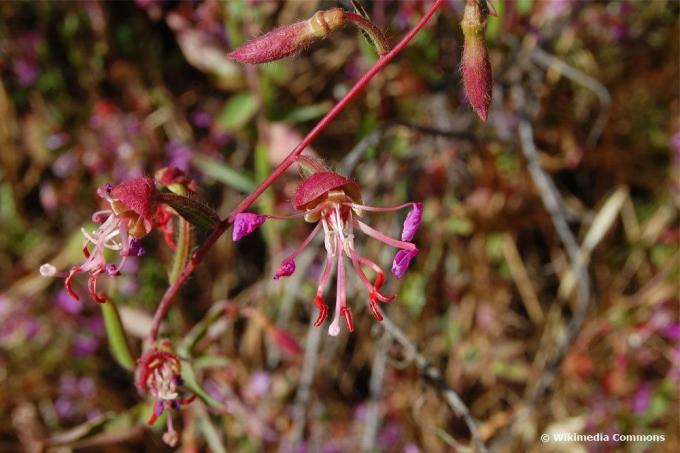
- Group planting for beds and borders
- Cut flower
- Growth height up to 60 cm
- Flowering period May to September
- Sow in early March
- Floor temperature 15 degrees
- Germination time 7 to 14 days
- cover lightly with soil
- keep moist
- later: sunny to partially shaded place
- well-drained soil
Ice plant (Dorotheanthus bellidiformis)
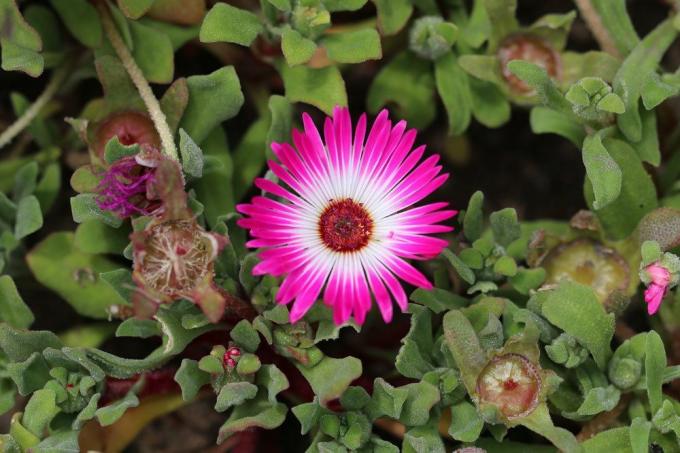
- Synonym: ice herb
- for edging, wall joints, flower beds, pots, rock gardens
- Growth height 10 to 25 cm
- Flowering time from May to frost
- Sow in early March
- Floor temperature 15 to 20 degrees
- Germination time 8 to 20 days
- Light germs
- just press it down and keep it moist
- Cover pots with foil
- sunny location in the garden
- normal garden soil
- Break out withered flowers
- The flowers only open when the sun is shining
Flowers to prefer P - Z
Petunia (Petunia hybrida)

- Balcony plant for tubs, pots, beds
- Growth height up to 30 cm
- Flowering time from May to frost
- Sow in February
- Floor temperature 20 to 22 degrees
- Germination time 10 to 18 days
- Light germs
- Just press the seeds on
- keep constantly moist
- under glass or foil
- Prick out as soon as the first pairs of leaves appear
- later: sunny location
- humic, well-drained soil
Purslane florets (Portulaca grandiflora)
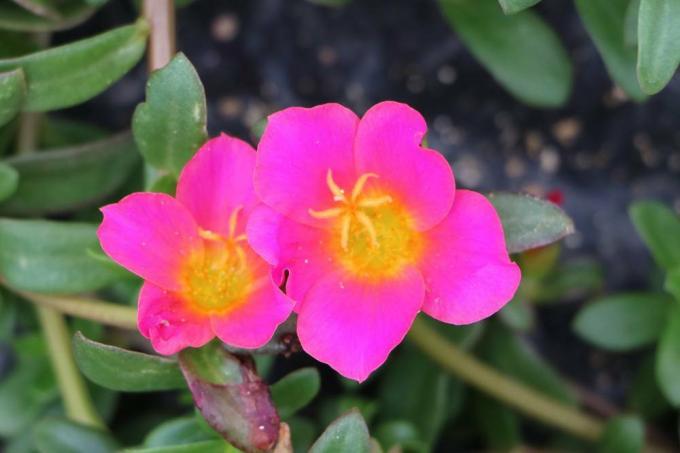
- for borders, flower boxes, hanging baskets
- Height of growth 15 cm
- Flowering period May to October
- Sow in February / beginning of March
- Floor temperature 18 degrees
- Germination time 7 to 14 days
- Sow in sandy soil
- Light germs
- Press the seeds lightly
- under glass / foil until it emerges
- keep moist
- then further cultivation cool and dry
- later: full sun
- well drained, poor soil
Delphinium ajacis
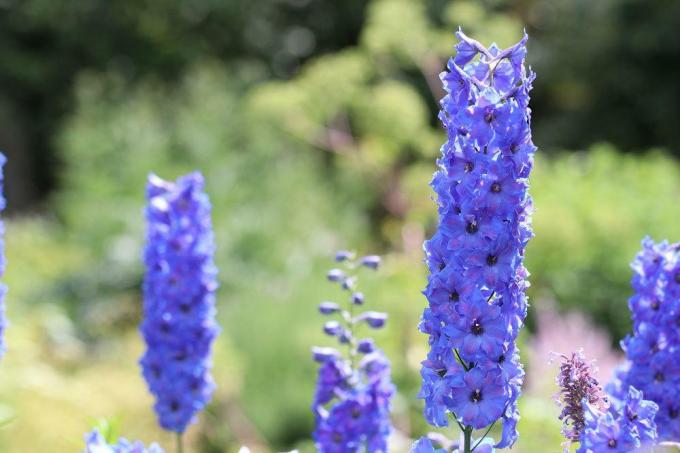
- annual
- Group planting for beds and borders
- Cut and dried flowers
- Growth height up to 110 cm
- Flowering period May to August
- Sow in February
- Floor temperature 21 to 24 degrees
- Germination time 18 to 25 days
- keep moderately moist
- later: sunny
- medium-heavy, loose, nutrient-rich soil
Sea lavender (Limonium sinuatum)

- Use as a dried flower, in bouquets
- Height of growth 60 to 80 cm
- Flowering period May to September
- Sow in early March
- Floor temperature 18 to 20 degrees
- Germination time 10 to 15 days
- Sow in sandy soil
- keep moist
- later: sunny to partially shaded
- sandy, poor soils
Everlasting flower (Helichrysum bracteatum)

- for beds, borders, cut flowers, dry bindery
- Growth height up to 80 cm
- Flowering period June to October
- Sow in early March
- Floor temperature 18 degrees
- Germination time 10 to 20 days
- Seed depth 1 cm
- later: sunny location
- well drained, humus soil
Zinnia (Zinnia)
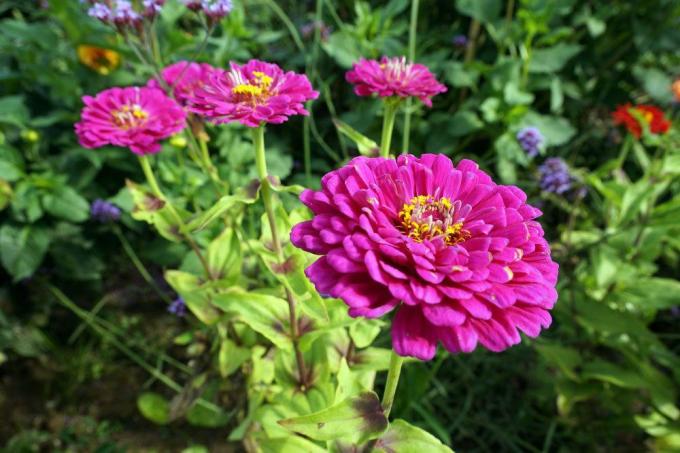
- for beds, cut flowers
- Growth height up to 50 cm
- Flowering period June to October
- Sow in early March
- Seed depth 1 cm
- press lightly, keep moist
- Floor temperature 18 to 21 degrees
- Germination time 5 to 7 days
- later: sunny location
- well drained, loamy soils
Light or dark germs?
In the preculture of flowers on the windowsill, it is important to consider whether the seeds are light or dark. The germination of the seed depends on this.
Dark germ
- Germination of the seed only in sufficient darkness
- germination is inhibited by light
- Cover the seeds with a thin layer of soil
- keep moist
Light germs
- Seeds need light to germinate
- just press lightly
- do not cover with soil
- keep moist
Tip: The seeds of the light germs can be covered with a sheet of newspaper while watering, so that they cannot be washed away.
Seed pot and substrate
Various vessels can be used to bring flowers to the windowsill. Of course, a small indoor greenhouse with a suitable hood, which fits exactly on the window sill, is ideal. However, there is no limit to your ingenuity. Can also be used
- Seed trays, especially for fine seeds
- small pots made of plastic or peat
- Yogurt pots
- Egg cartons
- peat-free coconut soaking pots, especially for cuttings and single sowing
In addition to the sowing containers, the substrate is of course decisive for success. Special potting soil should preferably be used here. This is sterilized and does not contain any fungal spores or other pathogens, as well as hardly any nutrients. This fact benefits the seedlings in their further development. The tender roots are stimulated to search for nutrients. This ensures good growth and branching of the roots. The substrate must always be loose and well-drained.

Tip: The lower half of the cultivation vessel can be filled with normal potting soil, then the potting soil comes on top.
Seeding procedure
As already noted, the right time to sow indoors is from the end of February to the beginning of March. This ensures that there will be strong plants by the time they are planted outdoors in mid-May. However, it is not only the timing that plays a decisive role, but also the correct approach to sowing. Here are a few tips on how to do this
- Fill the substrate loosely into containers
- Leave the upper edge of about 2 cm
- Smooth the earth with your hand or a wooden board
- Moisten the substrate with a fine shower head
- Spread seeds evenly on top
- not too close or on top of each other
- Cover the dark germinator with a thin layer of soil and press down lightly
- Light germinator no cover, just press seeds lightly
- pour everything lightly
- best to use an atomizer
- Label the label with name and date for marking
- Cover the vessel with a glass pane, plastic bag or foil
The sowing would now be done. For a good success, however, further care is crucial. Sufficient humidity or “tight air” is necessary for germination. A cover is therefore essential. This is removed once a day for ventilation. The seed pot can now find a bright place on the windowsill at temperatures around 20 degrees. Avoid high temperatures. The substrate must always be kept moist, but not wet.
After the seeds have emerged, shading is necessary on sunny days. On the other hand, on days with little sunlight, the vessel should be a little cooler, but not below 16 degrees. Otherwise it can quickly happen that the seedlings "die off". Weak, pale and thin plants then develop.
Prick out
When the plants reach a height of approx. 10 cm or two pairs of leaves have formed, the flowers should be pricked out. Before they are planted outdoors in mid-May, the young plants must be accustomed to the outside climate.
To do this, they are placed in partial shade in a protected place for a few days. In cool weather, fleece protection is required.
Tip: Fine seeds can be mixed with quartz sand before sowing or applied to the substrate with a coarser sieve. This makes it easier to distribute.
Dahlias & Co
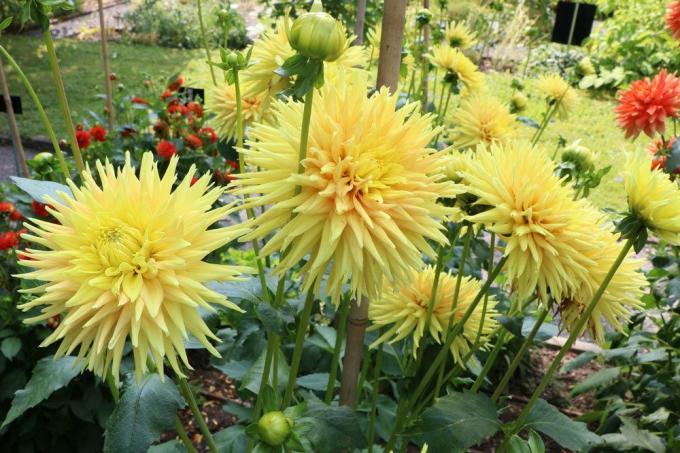
Dahlias, begonias or the Indian flower tube (Canna) are usually not planted outdoors until the end of May after the ice saints. Here, too, the tubers can be brought forward in the house from the end of February. To do this, they are planted in pots or bowls in humus and moist soil and given a light place on the windowsill. The tubers must then be kept moderately moist. This stimulates the formation of new shoots. The plants become stronger and more blooming.



